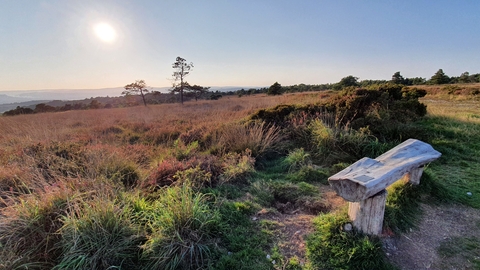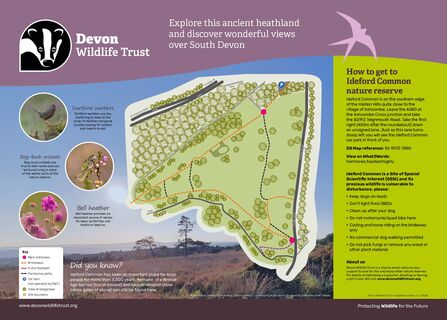
Ideford Common
Location
OS Map Reference
SX 9010 7880View on What3Words
Know before you go
Dogs
When to visit
Opening times
Open at all timesBest time to visit
All yearAbout the reserve
Great Haldon Heaths were notified as a Site of Special Scientific Interest (SSSI) in 1988. Ideford Common falls within this SSSI. Ideford Common represents about 2% of the remaining lowland heath in Devon.
Typical heathland species are abundant across the site and there are areas of silver birch and willow scrub, valuable for feeding nightjar, on the margins. These birds arrive in spring and depart in August. Visit the nature reserve at dusk during this time to hear their amazing churring calls.
Other of Ideford Common's birds include stonechats and Dartford warblers, while it is also a refuge for reptiles including common lizards and adders.
Visit in September to see a spectacular display of pink and purple coloured heather blooms.
A trip to Ideford Common also offers great year-round views across the Teign Valley and beyond to Dartmoor.
Ash dieback
The disease ash dieback is now widespread in the UK and is present at many of our nature reserves, so we carry out tree felling across our sites in winter months. For your own safety please observe temporary path diversions and closures.
Where possible we will leave affected ash trees in place to decay naturally as an important habitat for wildlife. We plan to only fell diseased ash trees which pose a threat to people or infrastructure. Before trees are felled, we will check whether any rare or protected wildlife is present. If it is, we will postpone or avoid felling these trees. No felling will take place during the bird nesting season.
DWT’s Saving Devon’s Treescapes project are working with communities, landowners and businesses to help make Devon's precious treescapes more resilient in the face of ash dieback. Find out how you can get involved here.
NOTICE: If you are visiting our reserves, please note that there have been instances of H5N1 Avian bird flu found in birds in Devon. There is very low risk to public health, but we do ask that if you come across any unusual or unexplained bird deaths on or near our reserves, please do not touch them and avoid allowing your dog to come into contact with dead birds. Please report them to Defra here or call 03459 335577 and also report your findings to DWT by email at contactus@devonwildlifetrust.org.

